Kaleidoscope Ringing
by Peter Dale, from Dover.
Stage 1
Inspired by Gordon Lucas from Langdon Hills, Essex, kaleidoscope ringing is a system of exercises involving a pair of bells.
The aims of the exercises are:
- bell control
- accurate striking
- the concept of “place”
These are the three basic exercises. From left to right, each one demands a higher level of bell control than the previous one. They are best introduced in this order:
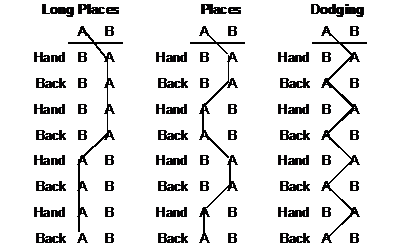
Note:
- The exercises continue until the conductor calls the bells involved to stop.
- It is advised to start from rounds, with only one pair of bells working at a time.
- With experience, different exercises can be rung at the same time in different pairs of places, not necessarily starting from rounds.
Illustration:
Long Places in 1-2, with places in 3-4, and dodging in 5-6.
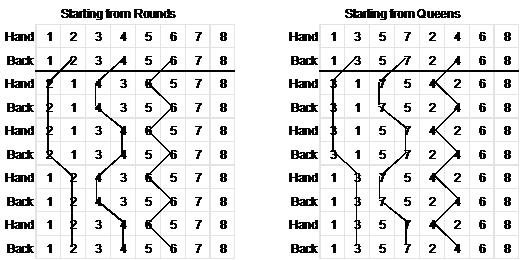
Note: “1-2”, “3-4”, and “5-6” refer to the pairs of places where the work is being done, not the bells that are actually doing it. Although different pairs of bells are involved in the second case, the pattern of kaleidoscope work is identical to the first case.
Kaleidoscope Ringing - Stage 2
(Inspired by Gordon Lucas from Langdon Hills, Essex.)
The three aims of elementary kaleidoscope are:
a) bell control, b) accurate striking, and c) the concept of “place”
From this stage onwards there is a new aim, which is to learn elements of method structure.
Dodges
Dodging at Stage 1 was a continuous exercise in bell control, coming tidily into rounds with only half a dodge at the end. We now analyse one complete dodge in isolation.
As with a popular Latin-American dance, it takes two to dodge and they swap places by doing it!
Illustration
First dodge, to swap 3 and 4:
Starting from rounds, bell 3 dodges “up”, ending in 4th’s place:
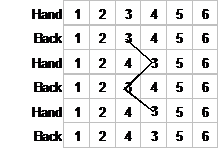
…carry on ringing 124356
Second dodge, to swap back:
From 4th’s place in 124356, bell 3 dodges “down”, ending in 3rd’s place once more:
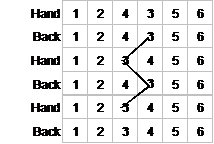
…”That’s all”
The hand strokes are in the general direction of movement; the dodge is in the opposite direction, a backstroke blow in the place you have just left. (N.B. Dodges in Grandsire and Stedman are hand-strokes.)
Kaleidoscope Treble Bob
Having acquired the bell control to perform each of the two dodges separately, we can join them together with a place to produce a single “piece of work” as follows:
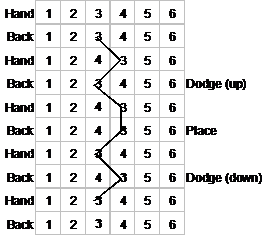
Notice that bell 4 does the same work as bell 3 but in the opposite direction, and the two bells end up in their original places.
It is worth learning this work thoroughly, in both directions
